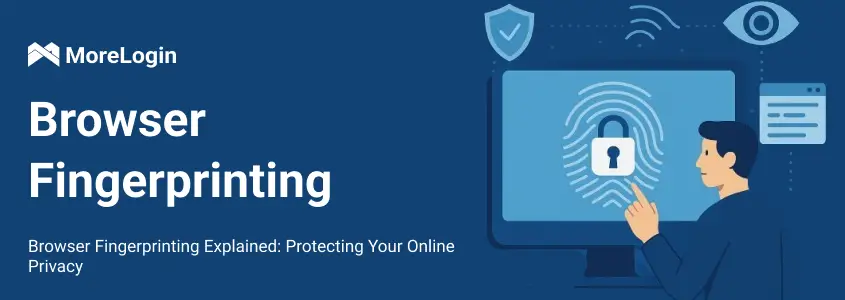
- Product

- Pricing
- Affiliate Program
- Use Cases
- Resource


In today's digital world, websites often use personalization and targeted advertising. Many users worry about how websites collect and track their data. One powerful but less familiar tracking method is browser fingerprinting. This method allows websites to gather detailed information about the user's browser and device.
This article explains what a browser fingerprint is, how it works, and how companies use it. It also shows how individuals can take simple steps to protect their privacy. Finally, the article describes how Morelogin helps users browse securely and avoid unwanted tracking.
A browser fingerprint is a unique digital profile created from the specific information your browser shares with websites when you go online. This data includes your browser type and version, operating system, screen resolution, language settings, installed plugins, time zone, and even fonts. When combined, these details create a distinctive browser fingerprint that can identify your device with surprising accuracy, often without the need for cookies.
Unlike traditional tracking methods such as cookies, browser fingerprinting does not rely on storing data on your device or asking for your consent. Because of this, it operates silently in the background, making it much harder to detect, block, or remove. This stealthy nature has made browser fingerprinting a powerful tool for tracking users across websites, raising serious concerns about privacy and online anonymity.
When a person visits a website, the browser sends data to help the page render correctly. This data reveals various characteristics of the device and browser being used. By compiling this information, websites and third parties can create a fingerprint that remains consistent across multiple browsing sessions.
A typical browser fingerprint includes:
Browser type and version
Operating system
Time zone and language settings
Screen resolution and color depth
Installed fonts and plugins
Device hardware (CPU, GPU, battery status)
Canvas rendering data
WebGL and AudioContext signatures
Touch screen capabilities
Browser window size
Each element by itself might not be unique. However, when these factors are combined, they produce a fingerprint that is likely distinct for every user.
Positive uses include:
Fraud prevention: Companies can detect login attempts from unknown devices or geographic locations and flag them as potentially suspicious.
Improved security: Financial institutions and secure platforms use fingerprinting to identify authorized devices and reduce account hijacking risks.
Negative uses include:
Cross-site tracking: Advertisers can track user activity across different websites, even if cookies are disabled.
Profiling and surveillance: Data collected through fingerprinting can be aggregated to build detailed user profiles, which are often used for advertising or sold to third parties.
Circumvention of privacy tools: Because fingerprinting does not rely on stored data, traditional privacy defenses like clearing cookies or using incognito mode are ineffective.
Although eliminating your browser fingerprint entirely is not possible, reducing its uniqueness and preventing consistent tracking is achievable with several strategies.
Users can disable JavaScript or limit access to sensitive browser APIs like Canvas, WebGL, and AudioContext. These APIs often reveal identifying data. Reducing their accessibility can help prevent fingerprint generation.
Browser extensions such as uBlock Origin, NoScript, and Privacy Badger block scripts that attempt to gather fingerprinting data. These tools give users more control over what data is shared with websites.
Privacy-focused browsers such as Brave or Tor automatically include anti-fingerprinting techniques. These browsers reduce the uniqueness of the browser environment by standardizing or masking certain data points.
A fingerprint browser allows users to simulate browser configurations. By rotating these configurations across sessions, users make it more difficult for trackers to build a consistent profile. This method is regarded by many as the best way to protect yourself from browser fingerprinting.
Virtual private networks (VPNs) and proxy servers mask a user's IP address and location. While they do not eliminate fingerprinting, they make it harder for websites to correlate a fingerprint with a real-world identity.
Specialized tools can spoof or randomize fingerprinting data. These tools generate false values for fingerprint attributes, making consistent tracking more difficult.
Morelogin is a powerful privacy solution designed to help individuals and teams manage multiple online identities without being tracked through fingerprinting. It enables users to create and manage multiple isolated browser environments, each with its own fingerprint and storage space.
Key features of Morelogin include:
Multi-Container Browser Profiles: Each browser profile runs in an isolated environment, maintaining separate cookies, local storage, and cache. This ensures complete sandboxing between profiles to prevent cross-site tracking and data leakage.
Team Collaboration with Privacy Controls: MoreLogin supports secure team collaboration by allowing multiple users to share access to online accounts without triggering platform detection algorithms that identify identical browser fingerprints.
Anti-Detection Technology: The platform uses advanced browser fingerprint spoofing and environment virtualization to make each profile appear as a unique device. This prevents account linking and reduces the risk of bans or restrictions imposed by anti-fraud systems.
Proxy Integration: Seamless proxy support allows routing traffic through residential or datacenter IPs, adding an extra layer of network-level privacy.
For further insight into using these tools safely, explore this short guide on fingerprint browser usage. It outlines practical techniques for improving anonymity during multi-account operations and preventing detection by fingerprinting systems.
Browser fingerprinting is a subtle but powerful method of tracking users online. Unlike traditional methods, it does not rely on stored data and is difficult to detect or block. Understanding what browser fingerprinting is, how it functions, and the various purposes it serves is essential for anyone who values online privacy.
Users can reduce tracking by using privacy-focused browsers, installing privacy extensions, and switching to fingerprinting browsers. These tools help create a less traceable browsing environment. Morelogin offers tools that protect user identities and allow secure access to online platforms. It helps users manage different browser profiles and avoid detection.